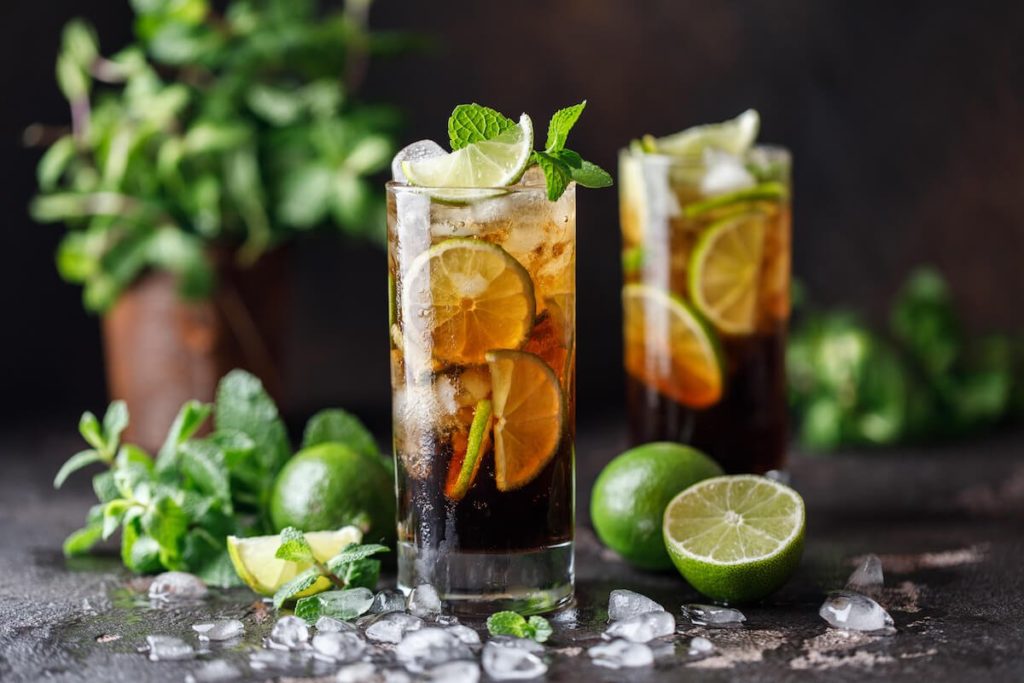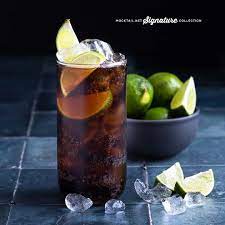LA FAMOSA BEBIDA CUBANA “CUBA LIBRE”, LA SEGUNDA MÁS POPULAR DEL MUNDO. FOTOS
El Cuba Libre es una mezcla de una bebida mezclada muy popular que puede resultarle a Ud. muy familiar. Esta simple bebida mixta es similar a un ron con Coca-Cola, pero la adición de jugo de lima fresco, que aligera la mezcla y elimina la dulzura de la cola, es lo que la distingue de la estándar. La lima debe ser fresca (no de una botella) para mantener la autenticidad de la bebida.
Este highball a menudo se conoce como ‘Ron y Coca Cola’ en los Estados Unidos y Canadá, donde el jugo de lima es opcional.
Los relatos de la invención del Cuba Libre varían. Un relato afirma que la bebida se inventó en La Habana, Cuba, alrededor de 1901/1902. Los patriotas que ayudaron a Cuba durante la Guerra Hispanoamericana y, más tarde, los emigrados cubanos regularmente mezclaban ron y cola como un trago y un brindis por esta isla, la mayor de las Antillas.
HISTORIA “CUBA LIBRE”
La segunda bebida más popular del mundo nació de un choque entre Estados Unidos y España. Ocurrió durante la Guerra Hispanoamericana a principios de siglo cuando Teddy Roosevelt, los Rough Riders y los estadounidenses en gran número llegaron a Cuba.
Una tarde, un grupo de soldados fuera de servicio del U.S. Signal Corps se reunió en un bar de La Habana Vieja. Fausto Rodríguez, un joven mensajero, recordó más tarde que el Capitán Russell entró y pidió ron Bacardí (Oro) y Coca-Cola con hielo y una rodaja de limón. El capitán bebió el brebaje con tal placer que despertó el interés de los soldados que lo rodeaban. Le pidieron al cantinero que les preparara una ronda de la bebida del capitán.
El ron Bacardi y Coca-Cola fue un éxito instantáneo. Como lo hace hasta el día de hoy, la bebida unió a la multitud en un espíritu de diversión y buen compañerismo. Cuando pidieron otra ronda, un soldado sugirió que brindaran ¡Por Cuba Libre! en celebración de la Cuba recién liberada. El capitán levantó su copa y entonó el grito de guerra que había inspirado a los victoriosos soldados cubanos en la Guerra de la Independencia.
Sin embargo, hay algunos problemas con el relato de Bacardí, ya que la guerra hispanoamericana se libró en 1898, la liberación de Cuba fue en 1898 y los Rough Riders abandonaron Cuba en septiembre de 1898, pero Coca-Cola no estuvo disponible en Cuba hasta 1900. Según una declaración de 1965 de Fausto Rodríguez, el Cuba Libre se mezcló por primera vez en un bar cubano en agosto de 1900 por un miembro del Cuerpo de Señales de EE. UU., conocido como “John Doe”.
Junto con el Mojito y el Daiquiri, el Cuba Libre comparte el misterio de su origen exacto. Lo único cierto es que este cóctel se bebió por primera vez en Cuba. ¿El año? 1900. Generalmente se dice que 1900 es el año en que la cola llegó por primera vez a Cuba, introducida a la isla por las tropas estadounidenses. Pero “¡Cuba Libre!” fue el grito de batalla del Ejército Libertador de Cuba durante la guerra de independencia que finalizó en 1898.
POPULARIDAD DE LA BEBIDA
Esta bebida alguna vez fue vista como exótica, con su jarabe oscuro, hecho (en ese momento) de nueces de cola y coca.
Muy pronto, como señala Charles H. Baker, Jr. en su Gentlemen’s Companion de 1934, el Cuba Libre “se impuso en todas partes del sur [estadounidense]… filtrado por el norte y el oeste”, ayudado por la amplia oferta de sus ingredientes En The American Language, 1921, H.L. Mencken escribe sobre una variación temprana de la bebida: “Los trogloditas del oeste de Carolina del Sur acuñaron ‘jump stiddy’ para una mezcla de Coca-Cola y alcohol desnaturalizado (normalmente extraído de los radiadores de los automóviles); se dice que los conocedores Prefería el sabor de lo que había sido envejecido en los Ford Modelo T”.
La bebida ganó más popularidad en los Estados Unidos después de que las Andrews Sisters grabaran una canción (en 1945) que lleva el nombre de los ingredientes de la bebida, “Rum and Coca-Cola”. La cola y el ron eran baratos en ese momento y esto también contribuyó a la gran popularidad de la mezcla.
El nombre de la bebida ha evolucionado un poco tanto en Cuba como en los Estados Unidos, donde algunos eligen referirse a ella como Mentirita (“una pequeña mentira”), en una referencia obstinada a la política cubana.
CUBAN FAMOUS DRINK “CUBA LIBRE”, THE WORLD’S SECOND MOST POPULAR. PHOTOS
The Cuba Libre is a popular mixed drink that you may find very familiar. This simple mixed drink is similar to a rum and Coke, but the addition of fresh lime juice, which lightens up the mix and cuts through the sweetness of the cola, is what distinguishes it from the standard. The lime should be fresh (not from a bottle) to keep the drink authentic.
This highball is often referred to as a Rum and Coke in the United States and Canada, where the lime juice is optional.
Accounts of the invention of the Cuba Libre vary. One account claims that the drink (Spanish for Free Cuba) was invented in Havana, Cuba around 1901/1902. Patriots aiding Cuba during the Spanish-American War — and, later, expatriates avoiding Prohibition — regularly mixed rum and cola as a highball and a toast to this West Indies island.
“CUBA LIBRE” STORY
The world’s second most popular drink was born in a collision between the United States and Spain. It happened during the Spanish-American War at the turn of the century when Teddy Roosevelt, the Rough Riders, and Americans in large numbers arrived in Cuba. One afternoon, a group of off-duty soldiers from the U.S. Signal Corps were gathered in a bar in Old Havana. Fausto Rodriguez, a young messenger, later recalled that Captain Russell came in and ordered Bacardi (Gold) rum and Coca-Cola on ice with a wedge of lime. The captain drank the concoction with such pleasure that it sparked the interest of the soldiers around him. They had the bartender prepare a round of the captain’s drink for them. The Bacardi rum and Coke was an instant hit. As it does to this day, the drink united the crowd in a spirit of fun and good fellowship. When they ordered another round, one soldier suggested that they toast ¡Por Cuba Libre! in celebration of the newly freed Cuba. The captain raised his glass and sang out the battle cry that had inspired Cuba’s victorious soldiers in the War of Independence.
However, there are some problems with Bacardi’s account, as the Spanish-American war was fought in 1898, Cuba’s liberation was in 1898, and the Rough Riders left Cuba in September 1898, but Coca-Cola was not available in Cuba until 1900. According to a 1965 deposition by Fausto Rodriguez, the Cuba Libre was first mixed at a Cuban bar in August 1900 by a member of the U.S. Signal Corps, referred to as “John Doe”.
Along with the Mojito and the Daiquiri, the Cuba Libre shares the mystery of its exact origin. The only certainty is that this cocktail was first sipped in Cuba. The year? 1900. 1900 is generally said to be the year that cola first came to Cuba, introduced to the island by American troops. But “Cuba Libre!” was the battle cry of the Cuba Liberation Army during the war of independence that ended in 1898.
POPULARITY OF THE DRINK
This drink was once viewed as exotic, with its dark syrup, made (at that time) from cola nuts and coca.
Soon enough, as Charles H. Baker, Jr. points out in his Gentlemen’s Companion of 1934, the Cuba Libre “caught on everywhere throughout the [American] South… filtered through the North and West,” aided by the ample supply of its ingredients. In The American Language, 1921, H.L. Mencken writes of an early variation of the drink: “The troglodytes of western South Carolina coined ‘jump stiddy’ for a mixture of Coca-Cola and denatured alcohol (usually drawn from automobile radiators); connoisseurs reputedly preferred the taste of what had been aged in Model-T Fords.”
The drink gained further popularity in the United States after the Andrews Sisters recorded a song (in 1945) named after the drink’s ingredients, “Rum and Coca-Cola”. Cola and rum were both cheap at the time and this also contributed to the widespread popularity of the concoction.
The drink’s name has evolved somewhat in both Cuba and the United States, where some choose to refer to it as a Mentirita (“a little lie”), in an opinionated reference to Cuban politics.
Agencies/ Wiki/ CubaLibreHist./ Spruceeats/ C. Graham/ Extractos/ Excerpts/ Internet Photos/ Arnoldo Varona/ www.TheCubanHistory.com
THE CUBAN HISTORY, HOLLYWOOD.










